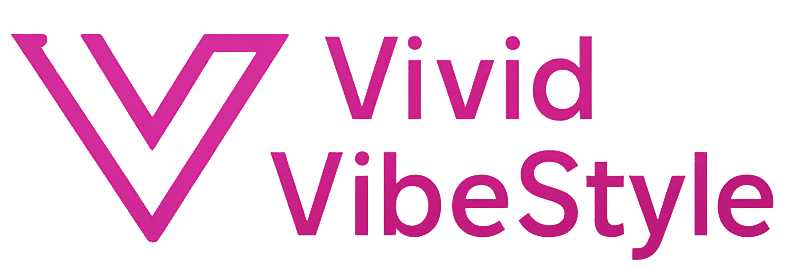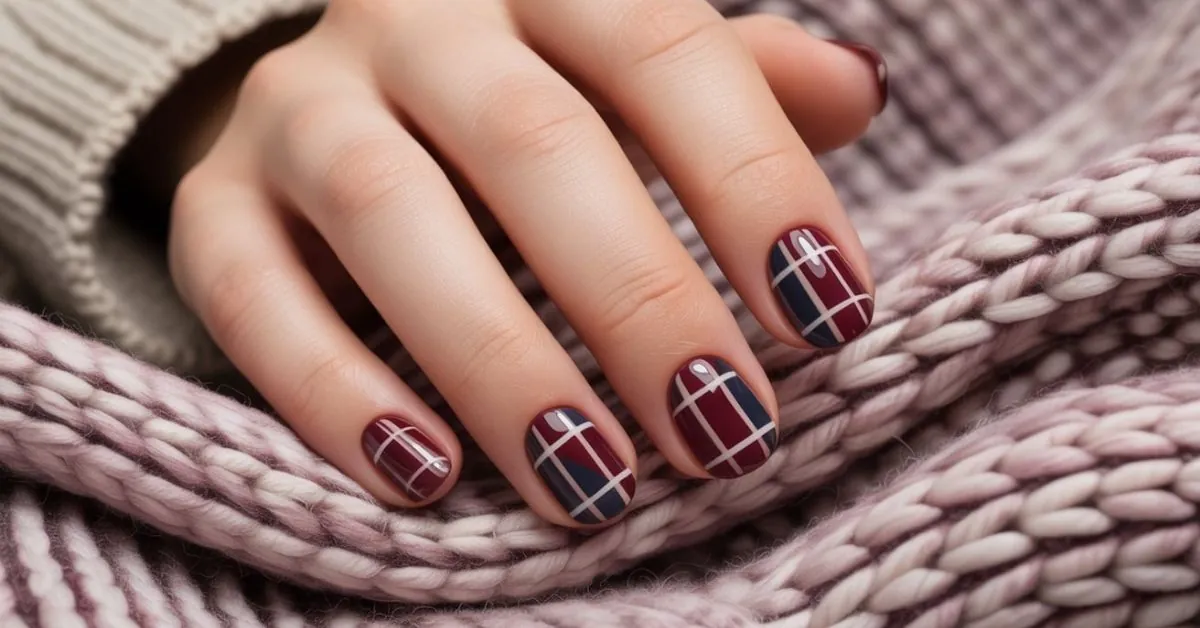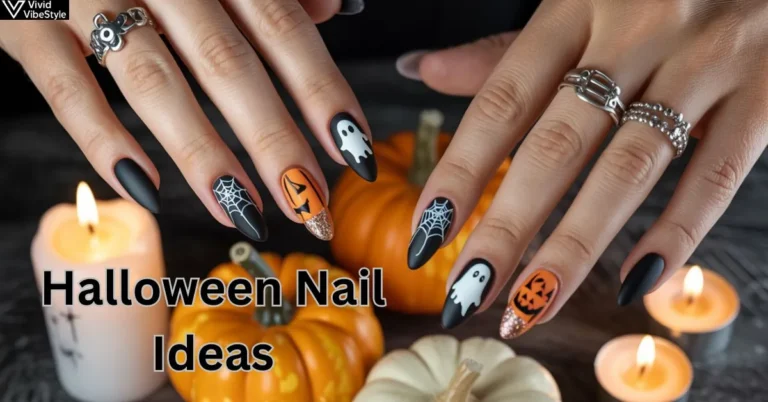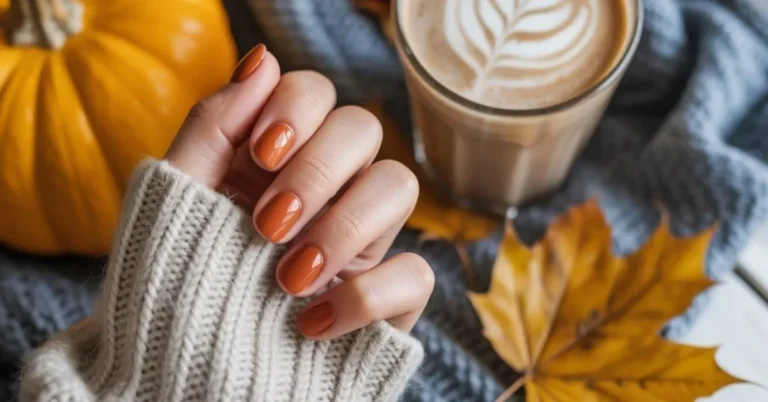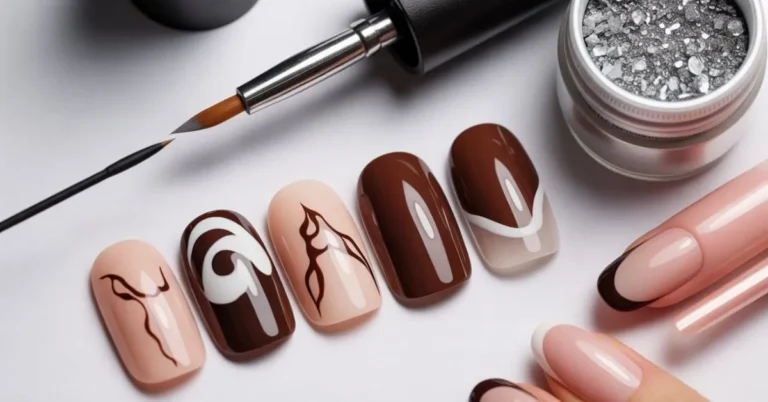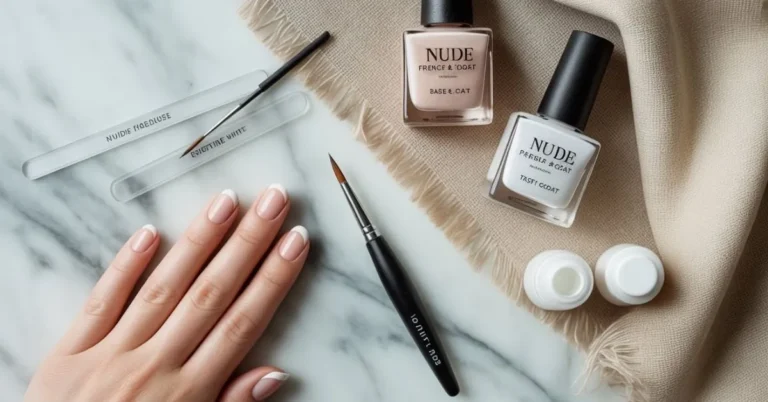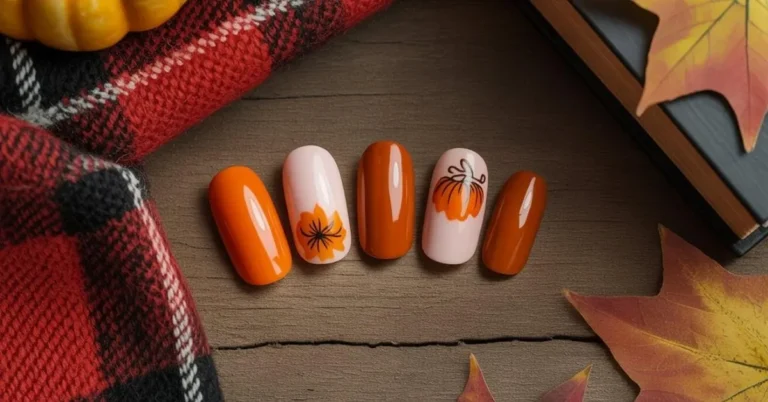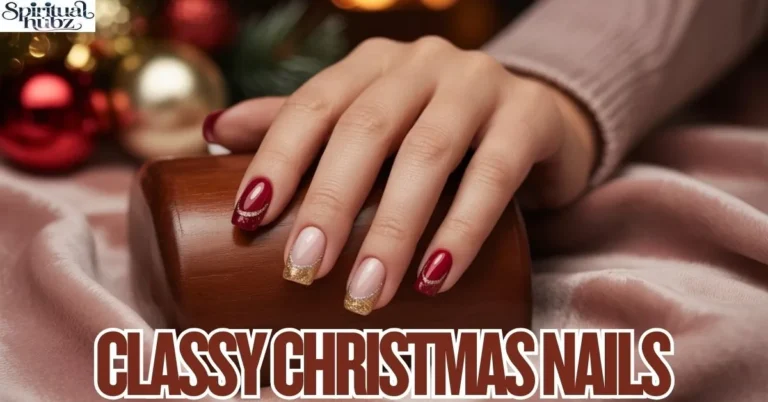Fall Plaid Nails Design: Master the Cozy Autumn Pattern Trend
You love the cozy aesthetic of fall fashion, but your nails look boring compared to your stylish plaid scarves and flannel shirts. Every time you see gorgeous plaid nail designs on social media, you feel intimidated by the intricate patterns that seem impossible to recreate at home. Traditional nail art tutorials make plaid patterns look overwhelming with complex techniques that leave you frustrated rather than inspired. You’re tired of settling for basic solid colors when you know your nails could perfectly complement your autumn wardrobe.
Here’s the exciting truth: fall plaid nails design is completely achievable with the right techniques and step-by-step guidance. This comprehensive guide reveals professional methods for creating cozy plaid nail art that captures autumn’s signature pattern in sophisticated, wearable designs. You’ll master tartan nail techniques, discover trending autumn plaid colors, and learn foolproof approaches that guarantee salon-quality results every time.
Why Are Fall Plaid Nails Design Trending in 2025?
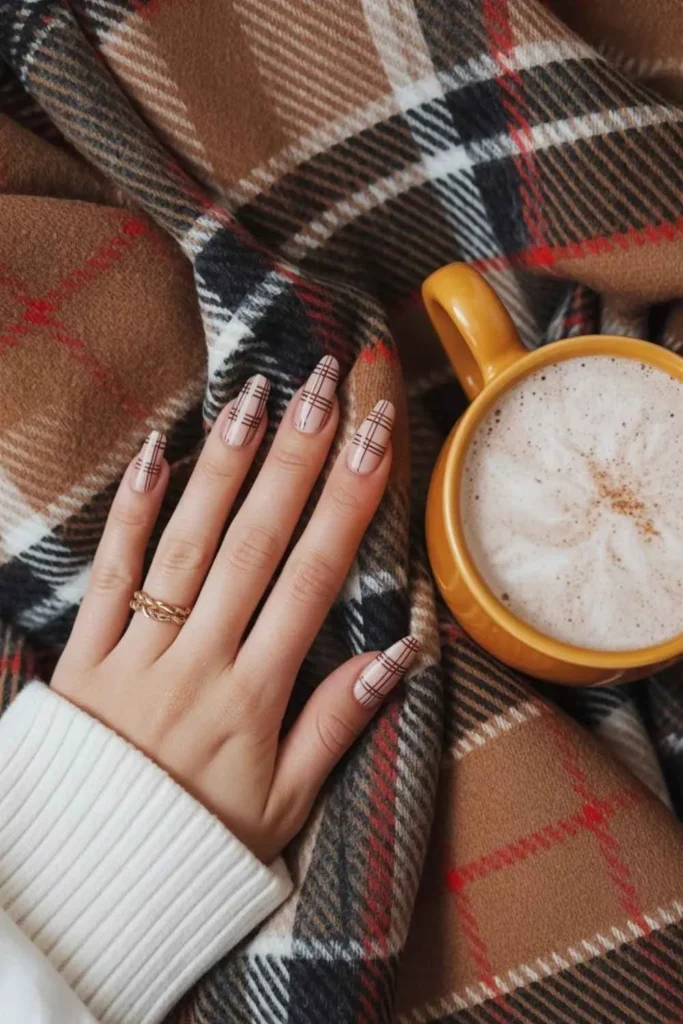
Fall plaid nails 2025 have emerged as the perfect way to capture autumn’s cozy aesthetic in wearable nail art. Goodbye floral prints, and hello plaid! This shift reflects fashion’s broader embrace of comfort-driven patterns that feel both nostalgic and contemporary. Plaid nail art trends perfectly mirror the season’s fashion emphasis on layered textures and warm, inviting patterns.
The sophistication of modern plaid nail designs lies in their versatility and timeless appeal. Do you love the warm colors, cozy vibes, and aesthetic patterns of fall? Plaid designs are good for more than your winter-weather flannel – they also make for picture-perfect autumn nails! Unlike trendy patterns that quickly feel dated, tartan nail art draws from centuries of textile tradition while feeling completely current.
Buff, green, and rust tones mix with cozy plaid and pumpkins. It’s like wearing a fall picnic on your fingertips. A playful fall nail idea that blends cottagecore charm with classic harvest vibes. This cottagecore influence explains why fall plaid nail designs feel so appealing they tap into our desire for comfort and connection to seasonal traditions while maintaining sophisticated nail art standards.
These fall plaid nails feature a chic combination of soft nude and white bases, accented with classic black and red plaid designs. Perfect for adding a cozy, autumnal touch to your look, these nails blend elegance with a hint of rustic charm. Professional nail artists are creating elegant plaid manicures that work beautifully in both casual and formal environments.
See Also : Pumpkin Orange Nails Design: 35+ Stunning Fall Nail Art Ideas That Capture Autumn Magic
How Do You Choose Perfect Fall Colors for Plaid Nail Art?
Selecting ideal fall plaid nail colors requires understanding how traditional plaid patterns translate onto curved nail surfaces while maintaining seasonal appropriateness. Professional plaid color selection considers both authentic plaid heritage and contemporary nail art aesthetics to create autumn plaid designs that feel both classic and current.
Traditional autumn plaid palettes embrace the rich, warm tones that define seasonal fashion. Think deep reds, rust colored oranges, berry shaded mauves, browns and muted greens and yellows and of course, navy blue. Try patterns like plaid, tortoiseshell and marble. These color combinations reflect autumn’s natural progression while maintaining the sophisticated contrast essential for readable plaid patterns.
Base color foundations establish the canvas for successful plaid nail designs. A khaki base or overall neutral palette for a plaid pattern creates a manicure that looks deceptively simple while providing sophisticated elegance. Neutral bases allow plaid patterns to shine without overwhelming the overall design or competing with seasonal wardrobes.
Contrast management ensures your fall plaid nails remain visible and authentic-looking. Traditional plaid requires sufficient contrast between intersecting lines to create the characteristic grid pattern. Professional plaid nail art balances readability with sophistication through careful color value selection.
Seasonal color adaptations allow autumn plaid nail designs to feel current throughout fall’s progression. Early autumn might embrace warmer browns and oranges, while late fall can incorporate deeper burgundies and forest greens. Evolving plaid color schemes keep designs feeling fresh and seasonally appropriate.
Skin tone considerations ensure your fall plaid nail colors complement rather than compete with your natural coloring. Warm undertones shine with rust oranges and golden browns, while cool undertones look stunning with berry purples and forest greens. Flattering plaid palettes enhance overall hand appearance while maintaining pattern integrity.
What Are the Essential Tools for Creating Professional Plaid Patterns?
Professional fall plaid nails design requires specific tools that ensure clean lines, consistent patterns, and authentic plaid characteristics. Amateur attempts often fail due to inadequate tools rather than poor technique. Investment in proper plaid nail art supplies transforms basic attempts into sophisticated results worthy of professional salons.
Fine liner brushes serve as the primary tools for detailed plaid nail art. Multiple sizes allow varied line weights that mimic authentic plaid fabric patterns. Use a thin nail art brush to draw fine white lines as pictured. Clean and dry your brush. Continue with fine black lines. Professional liner brushes provide the precision essential for clean plaid intersections.
Stamping equipment offers alternative approaches to complex plaid nail designs. The artist used a stamping technique in layers. After two coats of red, they stamped the green stripes, then the beige pattern. The trick is allowing plenty of time for each level to dry. Quality stamping plates featuring plaid patterns can produce consistent results more easily than freehand techniques.
Striping tape creates perfectly straight lines for geometric plaid nail art patterns. Professional tape leaves clean edges and prevents paint bleeding that ruins precise plaid intersections. Remove tape while polish remains slightly wet for cleanest lines in your tartan nail designs.
Quality base and top coats ensure long-lasting plaid nail art that maintains pattern clarity throughout wear. Ridge-filling base coats create smooth canvases essential for detailed line work, while durable top coats protect intricate patterns from premature wear and smudging.
Color organization systems streamline multi-color plaid applications. Arrange fall plaid colors from lightest to darkest, keeping frequently used shades easily accessible. Professional organization reduces application time and improves consistency across complex autumn plaid nail designs.
Which Step-by-Step Techniques Create Authentic Plaid Patterns?
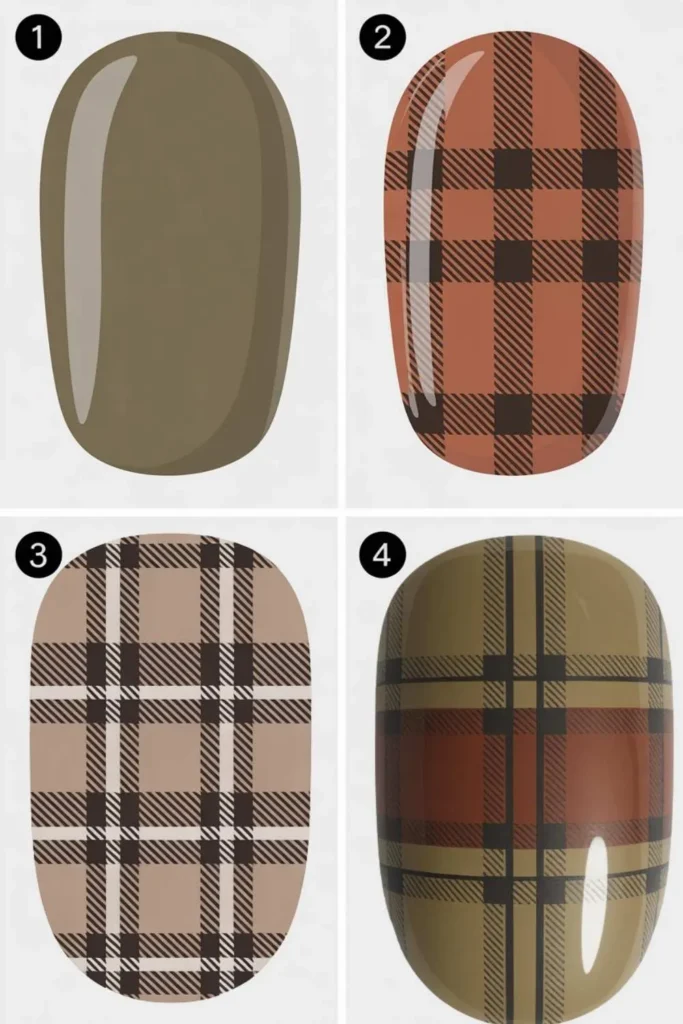
Mastering authentic fall plaid nails design requires understanding traditional plaid structure and translating it accurately onto nail surfaces. Professional plaid nail art techniques follow specific sequences that build patterns systematically, ensuring consistent results that capture genuine plaid characteristics.
Base preparation establishes essential foundations for successful plaid nail designs. Clean, shaped nails with smooth base coats provide ideal canvases for detailed pattern work. Professional plaid nail prep includes cuticle care and nail dehydration that prevents lifting during extended application periods.
Grid planning maps out plaid pattern placement before polish application begins. Visualize or lightly sketch where major lines will intersect, considering nail shape and proportion. Strategic plaid planning ensures patterns appear balanced and authentic rather than randomly placed.
Horizontal line creation forms the foundation of authentic plaid nail art. Apply base color completely, then add horizontal stripes in your chosen plaid colors using steady, even pressure. Allow 15 minute for your design to dry, then apply 2 coats of clear top coat to seal and smooth the design. Proper drying prevents smudging during subsequent steps.
Vertical line application completes basic plaid nail grid patterns. Cross horizontal lines with vertical stripes in coordinating or contrasting colors, creating characteristic plaid intersections. Professional intersection techniques require steady hands and proper paint consistency for clean crossings.
Pattern refinement adds authentic plaid details through selective line doubling and accent placement. Traditional plaid often features double lines or accent stripes that add complexity and visual interest. Advanced plaid techniques incorporate these subtle details that distinguish amateur from professional results.
See Also : Moody Gothic Nail Shades: Unleash Your Dark Beauty with Dramatic Colors
How Do You Adapt Plaid Designs for Different Nail Shapes?
Plaid nail art adaptation across various nail shapes requires understanding how pattern proportions affect visual balance and authenticity. Professional fall plaid nail designs consider nail dimensions and lifestyle factors to ensure patterns enhance rather than overwhelm natural nail characteristics.
Short nail techniques require careful plaid pattern scaling to prevent overcrowding while maintaining pattern readability. Focus on fewer, wider stripes that remain visible on limited nail surface area. Compact plaid designs work beautifully with accent nail approaches that feature full patterns on select fingers.
Long nail applications allow elaborate detailed plaid nail art with multiple intersecting lines and complex color combinations. Extended length provides canvas space for authentic plaid proportions that mirror traditional fabric patterns. Full-coverage plaid manicures work particularly well on longer nail shapes.
Almond shape considerations work naturally with organic plaid nail patterns because the tapered tips complement flowing line directions. Position major plaid intersections toward nail centers while allowing lines to follow natural shape curves in elegant plaid applications.
Square nail approaches benefit from geometric structured plaid patterns that respect the shape’s linear qualities. Align plaid grids with nail edges while maintaining authentic proportions. Angular plaid designs on square shapes create bold, contemporary effects perfect for statement manicures.
Stiletto adaptations create dramatic elongated plaid nail art through strategic pattern concentration. Focus detailed plaid work toward nail centers and allow simpler line work near sharp tips. Dramatic plaid applications enhance stiletto shapes’ natural impact while maintaining pattern integrity.
What Color Combinations Create Show-Stopping Fall Plaid Nails?
Fall plaid nail color schemes extend beyond traditional red and green combinations to include sophisticated palettes that reflect autumn’s complex beauty. Professional color theory applications ensure coordinated plaid nail designs feel intentionally curated rather than randomly assembled.
Classic autumn combinations embrace traditional fall plaid colors that mirror seasonal fashion staples. The deep burgundy base pairs perfectly with charcoal plaid lines, while subtle sparkles add that extra touch of glamour. It’s the perfect blend of classic and contemporary. These time-tested combinations work beautifully across multiple occasions and style preferences.
Monochromatic plaid approaches explore single color families in various tints and shades for sophisticated elegance. All-brown autumn plaid nail designs might include cream, tan, chocolate, and espresso for complex tonal variation. Monochromatic plaid patterns feel cohesive while maintaining visual interest through pattern rather than color contrast.
Cool-toned fall combinations work beautifully for contemporary plaid nail art that feels fresh and unexpected. Gray-based plaids with navy and cream accents, or purple-toned patterns with silver details create sophisticated modern plaid manicures perfect for professional environments.
Warm earth-tone palettes capture autumn’s cozy essence through rustic plaid nail designs. Rust oranges, golden browns, and cream combinations suggest harvest themes and country comfort. These combinations work particularly well with cottagecore plaid aesthetics that embrace rural charm.
Metallic accent integration elevates fall plaid nails through strategic shine placement. These festive nails combine traditional red and green plaid with shimmering gold accents. Metallic details add luxury without overwhelming classic plaid foundations, creating glamorous autumn nail art.
Which Advanced Techniques Add Sophistication to Plaid Nails?
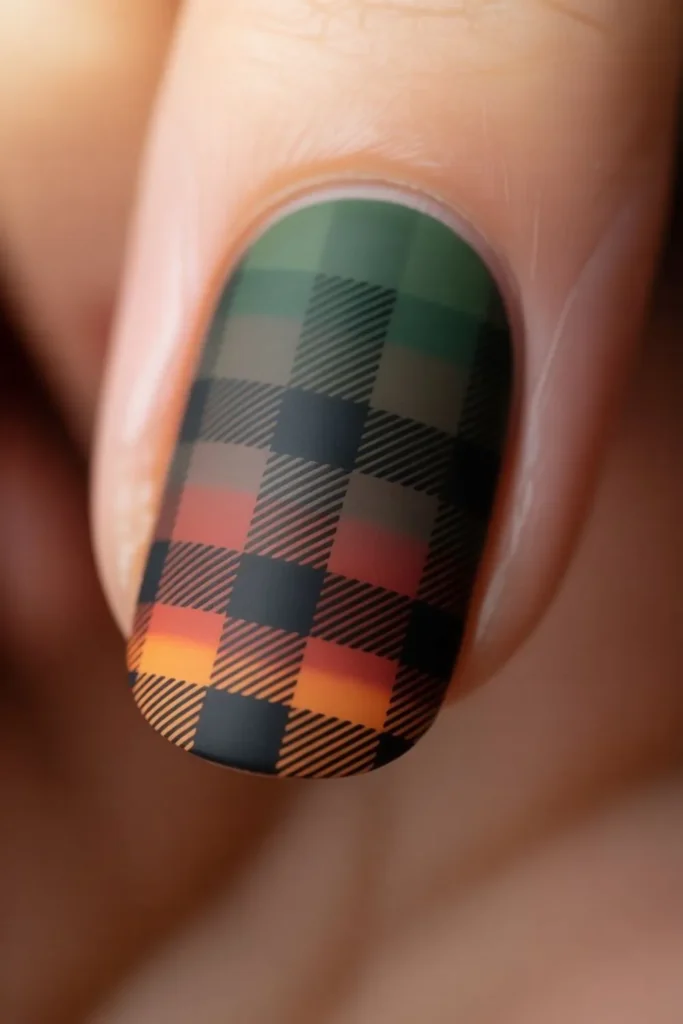
Advanced plaid nail art incorporates specialized techniques that transform basic grid patterns into professional-level artistic statements. Complex plaid nail designs require understanding traditional textile patterns and translating their sophisticated elements onto nail surfaces.
Layered plaid techniques create dimensional effects through multiple pattern applications. Start with base plaid patterns, then add secondary grids in complementary colors for authentic textile depth. Multi-layer plaid applications require careful timing and color selection to prevent muddy results.
Gradient plaid effects transition plaid patterns through subtle color changes for contemporary sophistication. Begin with full-intensity plaid at cuticles and gradually fade toward tips, or create ombré plaid nail art that shifts between related color families while maintaining pattern structure.
Textural plaid applications add tactile interest through varied finish combinations. Combine matte and glossy elements within single plaid patterns, or incorporate subtle texture powders that suggest fabric weave. Dimensional plaid nail art engages multiple senses while maintaining visual appeal.
Mixed media plaid combinations pair traditional patterns with complementary nail art techniques. Stamped plaid accents over gradient bases, or hand-painted details combined with stamped foundations create unique hybrid plaid designs impossible to achieve through single techniques.
Negative space plaid patterns use strategic polish placement to suggest rather than explicitly state traditional plaid elements. Modern minimalist plaid might feature selected intersections while leaving other grid areas natural for contemporary sophistication.
See Also : Velvet Nails Design: Complete Guide to Flocking Powder Techniques & 2025 Trends
How Do You Create Perfect Plaid Accent Nail Combinations?
Plaid accent nail strategies offer perfect introduction to complex patterns while maintaining overall manicure sophistication. Strategic accent placement creates balanced autumn nail designs that feel intentional rather than overwhelming. Professional accent techniques maximize visual impact while respecting workplace and lifestyle requirements.
Single accent approaches feature detailed plaid nail art on ring fingers while maintaining solid autumn colors on remaining nails. This classic technique provides pattern interest without commitment to full plaid nail designs. Choose accent colors that coordinate with but don’t exactly match base shades for sophisticated contrast.
Coordinated accent combinations pair plaid nail patterns with complementary autumn elements on different fingers. Mixed autumn nail art might combine plaid accents with solid colors, subtle leaf details, or seasonal gradients for cohesive yet varied manicures.
Graduated plaid effects transition from simple solid colors through minimal patterns to full complex plaid designs on accent fingers. This approach creates sophisticated flow across the manicure while showcasing detailed plaid artistry without overwhelming the overall aesthetic.
Seasonal element integration combines fall plaid nail art with other autumn themes for comprehensive seasonal manicures. Coordinated autumn designs might feature plaid patterns alongside harvest elements, leaf motifs, or seasonal color gradients for complete fall nail storytelling.
Professional accent balance ensures plaid nail accents enhance rather than compete with overall hand presentation. Consider lifestyle requirements, outfit coordination, and occasion appropriateness when selecting accent placement and intensity for workplace-friendly plaid applications.
What Common Mistakes Should You Avoid in Plaid Nail Art?
Common plaid nail art mistakes prevent otherwise skilled nail artists from achieving professional-quality results. Understanding these pitfalls helps create sophisticated fall plaid designs that rival salon quality while avoiding amateur appearance markers that undermine overall elegance.
Line weight inconsistency represents the most frequent plaid nail design mistake. Authentic plaid features varied line weights that create visual hierarchy and pattern authenticity. Avoid uniform line thickness throughout patterns traditional plaid includes both fine accent lines and bold primary stripes.
Color value errors make fall plaid nails either invisible or overwhelming. Insufficient contrast renders patterns barely visible, while excessive contrast creates harsh effects that feel unnatural. Professional plaid color selection balances readability with sophistication through careful value consideration.
Pattern placement problems often concentrate plaid designs awkwardly on nail surfaces without considering natural proportions. Traditional plaid patterns should flow naturally across nail shapes rather than appearing cramped or randomly positioned. Strategic plaid planning ensures authentic appearance.
Intersection mistakes create muddy or unclear plaid pattern crossings that destroy pattern authenticity. Lines should cross cleanly without smudging or color mixing. Professional intersection techniques require proper timing and paint consistency for crisp pattern definition.
Rushing between layers prevents proper drying that causes smudging and color contamination in detailed plaid nail art. Allow complete drying between horizontal lines, vertical applications, and final details. Patient plaid application prevents problems requiring complete restart.
How Do Seasonal Fashion Trends Influence Plaid Nail Choices?
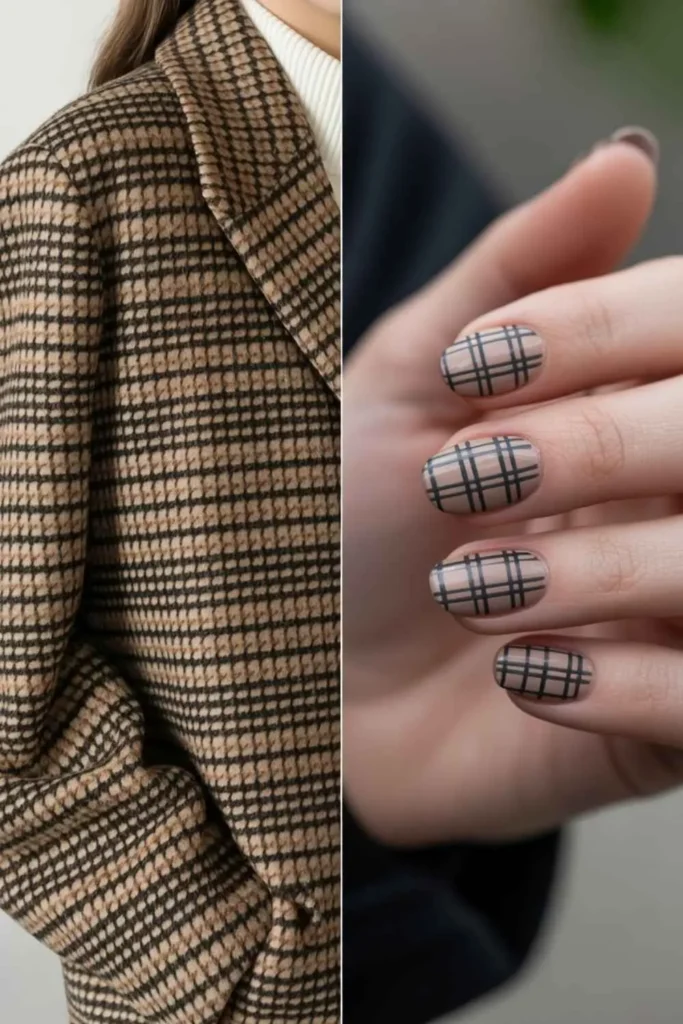
Seasonal plaid nail trends adapt traditional patterns to reflect broader fashion movements while maintaining classic appeal. 2025 fall plaid influences incorporate contemporary styling preferences and color innovations that keep traditional plaid nail art feeling current and relevant.
Cottagecore plaid aesthetics embrace softer, more romantic interpretations of traditional patterns. A playful fall nail idea that blends cottagecore charm with classic harvest vibes shows how modern plaid applications incorporate gentler color palettes and organic pattern variations that feel comfortable and inviting.
Minimalist plaid approaches reflect contemporary preference for understated sophistication over bold statements. Subtle plaid nail designs might feature tonal variations or simplified patterns that suggest rather than explicitly state traditional plaid elements. These approaches work particularly well in professional environments.
Vintage plaid revival draws inspiration from specific historical periods and textile traditions. Retro plaid nail art might incorporate authentic color combinations and pattern proportions from particular decades, creating nostalgic effects that feel both familiar and fresh.
Luxury plaid interpretations elevate traditional patterns through premium color selections and sophisticated application techniques. High-end plaid manicures might incorporate metallic accents, subtle shimmer, or complex color layering that suggests expensive textile patterns.
Sustainable plaid consciousness reflects growing environmental awareness in beauty choices. Eco-friendly plaid nail art uses non-toxic polishes and techniques that minimize waste while maintaining sophisticated pattern quality and authentic plaid characteristics.
See Also : Short Leopard Print Fall Nails: 2025’s Hottest Animal Print Nail Trend
Frequently Asked Questions
How long do fall plaid nail designs typically last?
Professional plaid nail art maintains pattern clarity for 7-10 days with proper application techniques and quality products. Durable plaid manicures require quality base coats, proper drying between pattern layers, and protective top coats. Complex plaid patterns may require touch-ups around day 5-7 to maintain crisp line definition, especially at high-wear areas like nail tips.
What’s the easiest plaid pattern for beginners to start with?
Simple two-color plaid designs work best for beginners, featuring basic horizontal and vertical line intersections in contrasting colors. Start with basic tartan patterns using wide lines rather than attempting complex multi-color plaids. Practice on nail wheels or paper templates before attempting final applications on natural nails.
Can you create plaid nails without special brushes?
While professional liner brushes provide optimal results, DIY plaid alternatives include using striping tape for straight lines or repurposing small craft brushes. Beginner plaid techniques can utilize bobby pins for thin lines or nail art pens for more controlled application, though results may vary from professional tool applications.
Which nail shapes work best for plaid patterns?
Medium to long nail lengths showcase detailed plaid patterns most effectively by providing adequate canvas space for pattern development. Square and oval shapes work particularly well because they offer good proportions for balanced plaid grids. Very short nails benefit from simplified plaid patterns or accent nail approaches.
How do you fix mistakes in plaid nail art?
Plaid correction techniques depend on mistake timing and severity. Wet polish mistakes can be corrected with cleanup brushes dipped in acetone. Dried plaid mistakes often require strategic pattern additions to incorporate errors into overall designs, or selective removal and reapplication of affected pattern elements while preserving surrounding work.
Conclusion
Fall plaid nails design represents the perfect fusion of seasonal comfort and sophisticated nail artistry, offering endless opportunities for expressing autumn’s cozy aesthetic through wearable, professional-quality manicures.
The techniques, color combinations, and professional approaches outlined here provide comprehensive foundations for creating stunning plaid nail art that rivals salon quality while capturing the season’s most beloved pattern in elegant, contemporary applications.
Remember that exceptional plaid nail artistry develops through consistent practice with quality tools and systematic skill building. Start with simple two-color plaid designs using basic horizontal and vertical techniques, then gradually incorporate advanced methods like gradient effects, textural applications, and complex color combinations as your confidence grows.
The timeless appeal of autumn plaid patterns provides endless inspiration for creating memorable manicures that perfectly complement fall’s cozy fashion aesthetic while maintaining sophisticated elegance suitable for any occasion.
Ready to embrace autumn’s coziest trend? Start with quality liner brushes, practice basic grid techniques, and let your nails become the perfect canvas for expressing fall’s most beloved pattern with professional sophistication.
